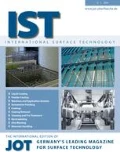Highly alkaline cleaning products with a high surfactant content are often used for removing heavy contamination. A new product which is exempt from special labelling requirements has been developed specifically for low temperature cleaning. It produces results at temperatures below 40 °C similar to those of highly alkaline systems.

A cleaning agent that requires no special labelling, is low-foaming and produces highly effective results has been developed for low-temperature cleaning processes.
Heavy contamination, including combinations of graphite and oil, rust preventive materials and cutting oils that have become resinous, generally has to be removed using highly alkaline cleaning agents with a high surfactant content. Under normal conditions, it is rarely possible for mildly alkaline or neutral systems to perform tasks of this kind. However, because the operators of cleaning machines usually come into direct contact with the cleaning agent, the use of corrosive, highly alkaline products should be avoided wherever possible. As a result, complex and costly machinery is often needed to achieve the required cleaning effect.
Kluthe has developed its Hakupur 445 LF cleaning agent, which produces similar results to those of highly alkaline systems and can be used at temperatures below 40 °C, specifically for this purpose. The cleaning product requires no special labelling and is based on surfactants that are most effective at temperatures around 40 °C.
The newly developed cleaner has another advantage over alkaline media, which often form large quantities of foam in combination with rust preventive products and greases. The combination of surfactants in the new product has been selected to counteract the build-up of foam even in unfavourable conditions. This means that in situations where a defoaming agent would normally be needed, it can generally be dispensed with when using Hakupur 445 LF. In most cases, this reduces the number of different products used and, caused by formation of foam, keeps production downtime to a minimum.
In addition, the cleaning agent, which is compatible with a variety of metals, separates out dragged-in oils more effectively and results in a much lower incidence of marks on the cleaned components. It also has a self-cleaning effect, because it dissolves residues in machines and, as a result, there is less likelihood of deposits building up. The cleaning machines remain clean for longer than would be the case with conventional neutral cleaning agents or alkaline products and this in its turn leads to a longer service life and longer maintenance intervals. Furthermore, because of its low-foaming surfactants, the newly developed product can be sprayed at ambient temperature and remains highly stable even at pressures above 20 bar.
Author information
Authors and Affiliations
Consortia
Rights and permissions
About this article
Cite this article
Springer Fachmedien Wiesbaden. Mildly Alkaline Cleaning Agent. Int Surf Technol 6, 35 (2013). https://doi.org/10.1365/s35724-013-0148-9
Published:
Issue Date:
DOI: https://doi.org/10.1365/s35724-013-0148-9

